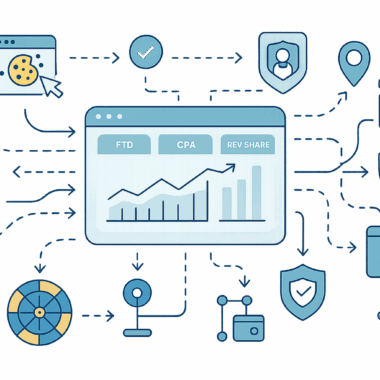

What Is iGaming Affiliate Management Software and How Does It Work?

Content:
- Core Modules & Architecture
- Tracking Mechanics (Click → Registration → FTD)
- Attribution & Commission Logic
- Integrations & Data Flow
- Partner Lifecycle & Automation
- Fraud Prevention, Compliance & Responsible Gambling
- Payments, Reconciliation & Tax
- Conclusion
- FAQ
iGaming affiliate management software is the operational layer that connects operators with traffic partners and turns clicks into compliant, reconciled revenue. The platform centralizes tracking, commissioning, reporting, and payments while enforcing regulatory and brand standards. Without a specialized stack, teams drown in inconsistent data, manual approvals, and unresolved disputes that erode margin.
The software sits alongside an operator’s core systems—player account management (PAM), sportsbook or casino platform, wallet/payments, KYC/AML, CRM, and BI. It exchanges events, calculates partner compensation against agreed rules, and exposes transparent evidence for every decision. The outcome is predictable unit economics: accurate attribution, faster reconciliation, and scalable partner operations across multiple brands and jurisdictions.
Core Modules & Architecture
Modern platforms follow a modular design so operators can add capacity and controls without re-engineering the entire stack. Core modules typically include a partner CRM, link and creative management, server-to-server postbacks for events, a rules-driven commission engine, analytics and exports, and a payout hub. A robust API/webhook layer ensures the system behaves like part of your internal tooling rather than a black box.
Architecture choices affect latency, resilience, and compliance posture. SaaS delivery offers speed and lower maintenance; white-label deployments add brand control; in-house builds maximize customization at the cost of longer timelines. Multi-brand and multi-geo operators need strict tenant separation, currency handling, and timezone normalization. Raw click and conversion logs should be retained under a documented policy to support audits and partner disputes.
Typical module checklist
- Partner CRM and roles/permissions
- Offer/library management with versioning
- Tracking and postback ingestion with idempotency
- Commission engine with simulation and audit trail
- Reporting/ETL to BI or warehouse
- Payout orchestration and invoice generation
Tracking Mechanics (Click → Registration → FTD)
Tracking starts when a tagged link carries an affiliate ID and a unique click identifier to the operator’s landing page. The platform records the click, sets first-party storage where allowed, and forwards the user to the target URL. Subsequent milestones—registration, KYC pass, first deposit (FTD), wagers, and refunds—flow back via server-to-server postbacks that include order-safe identifiers, monetary values, and timestamps. Idempotent keys prevent double counting when retries occur after timeouts.
Data integrity depends on a defined event contract. Each payload should include click ID, partner ID, campaign, currency, and consent state. Cross-domain paths and app hand-offs require deep links and, where permitted, privacy-safe identity stitching. Operators should validate payloads at the edge, queue events for retry with exponential backoff, and store the original body for forensic analysis. This disciplined pipeline stabilizes attribution and shortens reconciliation cycles.
Minimum event fields (non-exhaustive):
- Click: click_id, affiliate_id, campaign, ts, user_agent, ip
- Registration: click_id, player_id, ts, geo, consent
- FTD: player_id, tx_id, amount, currency, ts, payment_method
- Wager/Net: player_id, stake, win, bonus_applied, ts
Attribution & Commission Logic
Attribution determines who receives credit and how much they are paid. iGaming programs rely on configurable models with partner-specific lookback windows, channel priority rules, and de-duplication across sub-affiliates and paid media. Upper-funnel content often earns position-based weight, while coupon or toolbar traffic receives shorter windows to reduce brand collision. Every conversion should store the rule version applied to ensure disputes resolve with evidence rather than negotiation.
Commissioning translates attribution into money. The engine must handle CPA, Revenue Share (RevShare) on GGR/NGR, and Hybrid deals, including tiered rates, negative carryover policy, and clawbacks after refunds or chargebacks. Simulations let finance test rule changes before production. For multi-brand operators, brand-level margins and taxation rules flow into NGR to keep economics accurate.
Commission models (comparison)
|
Model |
Trigger | Payout Basis | Strengths |
Watchouts |
| CPA | Verified registration or FTD | Fixed amount per event | Simple forecasting; fast partner cash flow | Risk of bonus abuse; align with KYC and fraud checks |
| RevShare (GGR/NGR) | Net gaming revenue over time | % of GGR or NGR | Aligns incentives with lifetime value | Requires clear NGR formula, negative carryover rules |
| Hybrid | CPA + RevShare | Mix of fixed + % | Balances acquisition and retention | More complex reconciliation and contract tracking |
Reference NGR: NGR = GGR − (bonuses + taxes/levies + payment fees + chargebacks). Document each component to avoid ambiguity.
Integrations & Data Flow
The platform succeeds only if it integrates cleanly with the operator’s ecosystem. Native connectors to PAM/casino platforms, sportsbook engines, wallets, payment gateways, KYC/AML providers, CRM/CDP, and data warehouses reduce time-to-value. Where native links do not exist, stable REST endpoints and webhooks with signed requests, pagination, and rate limits are mandatory. A sandbox with production-like behavior enables safe end-to-end QA before launch.
Data contracts keep systems synchronized. Event schemas should be versioned with change logs, and currency conversions must record both source and settlement currency to avoid reconciliation drift. Time should be stored in UTC with explicit timezone rendering in the UI. Failed deliveries must trigger retries and alerting; successful deliveries should return correlation IDs so incidents can be traced across systems.
Integration due-diligence bullets
- Idempotency keys and duplicate suppression
- Backfill options for historical transactions
- Scheduled ETL exports for finance, tax, and BI
- Health endpoints and status pages for uptime transparency
Partner Lifecycle & Automation
A scalable program treats partner operations as a governed funnel, not a ticket queue. Recruitment should use ICP scoring with automated vetting of traffic sources and disclosures. Onboarding provides a self-serve link builder, deep-link validator, and a creative library with expiry metadata. Tiering rules set default rate cards and probation thresholds so expectations are clear from day one.
Lifecycle automation maintains momentum after go-live. Drip enablement shares seasonal promos, odds or game updates, and conversion tips by geography. Performance alerts trigger when KPIs deviate from plan, and auto-pauses protect margin during anomalies. Partners receive transparent dashboards that show approved offers, pending actions, and time-to-first-FTD—metrics that correlate directly with future revenue.
Recommended lifecycle automations
- Application → KYC → tier assignment with default rates
- Pre-flight checks (tags, postbacks, feeds) with prescriptive fixes
- 14/30-day performance review and auto-promotion or coaching
- Inactivity rules that recycle inventory and archive idle links
Fraud Prevention, Compliance & Responsible Gambling
iGaming attracts sophisticated abuse—multi-accounting, bonus cycling, click spam, cookie stuffing, and location spoofing. Effective fraud prevention layers device and IP reputation, ASN filtering, velocity thresholds, and session integrity checks. High-risk events route to manual review; payouts remain on hold until signals clear. Historical re-scoring releases or claws back funds when models improve.
Compliance is not optional; the platform must help enforce licensing terms and responsible gambling obligations. Controls include geo-fencing, age/KYC verification, self-exclusion synchronization, mandatory marketing disclosures, and immutable audit logs. Evidence packs—SERP screenshots, tracking paths, timestamps, and rule versions—shorten investigations and demonstrate due diligence to regulators and payment providers.
Control layers to implement
- Brand bidding and keyword monitoring with graded penalties
- Checkout code whitelists and coupon misuse detection
- Disclosure checks for publisher content and social placements
- Thresholds that halt campaigns when self-exclusion or geo rules trigger
Payments, Reconciliation & Tax
Payments close the loop between partners and finance. The payout hub should support multi-currency balances, automated invoice generation, scheduled approvals, and disbursement via e-wallets or bank transfers. Payout aging alerts (15/30/45 days) prevent backlogs that harm partner trust. Partners need a line-item ledger that shows the path, rule version, and calculation steps for every paid event.
Reconciliation aligns marketing, product, and accounting truth. The system must map commissions to NGR/GGR definitions, apply negative carryover where contracts require, and account for refunds, chargebacks, and payment fees. VAT/GST handling varies by jurisdiction, so tax codes and documentation should be applied at the transaction level and exported to the ERP with clear references for audits.
Finance checklist
- Daily totals reconciliation across tracking, BI, and ledger (variance target ≤1%)
- Contract metadata driving rate cards, tiers, and carryover rules
- Exportable audit trails and document packs for month-end close
Conclusion
iGaming affiliate management software turns partner marketing from a manual process into a governed operating system. By standardizing tracking, codifying attribution and commissions, integrating with finance and compliance tools, and automating payouts, the platform delivers scale without sacrificing accuracy or regulatory posture. Operators gain predictability: faster activation, cleaner data, and transparent economics across brands and regions.
Adopt a staged rollout to reduce risk. Stabilize the event pipeline, finalize commission logic with finance, automate partner lifecycle workflows, and then harden fraud and compliance layers. Measure each step with clear KPIs—variance, approval latency, chargeback rate—so improvements are demonstrable and durable.
FAQ
What is the difference between GGR and NGR in RevShare?
GGR (gross gaming revenue) equals stakes minus winnings. NGR deducts bonuses, taxes/levies, payment fees, and chargebacks from GGR. Contracts should reference the exact formula to avoid ambiguity and disputes.
Do operators need both affiliate software and a BI warehouse?
Yes. The affiliate platform is the payout ledger and workflow engine; BI verifies totals, builds cohorts, and quantifies lifetime value. Nightly reconciliation between the two keeps decisions defensible.
How are sub-affiliates tracked and paid?
Clicks and conversions carry a parent/child hierarchy so revenue can be split according to the downline structure. The system should expose sub-affiliate reports, apply inherited rules, and prevent double counting with unique IDs.
Which lookback windows are typical for iGaming?
Short windows for incentive-driven traffic (1–3 days) and longer windows for content-driven discovery (7–14 days). High-consideration products may require up to 30 days. During brand bursts, shorten windows to reduce channel collision.
How do platforms mitigate bonus abuse without blocking legitimate play?
Combine KYC strength, device/IP reputation, velocity rules on deposits and withdrawals, and limits on bonus eligibility. Tie CPA to verified FTD and apply clawbacks for churned or fraudulent activity, with transparent evidence available to partners.
Affiliate Agreement Guide: Terms, Templates & Compliance for Your Program
When it comes to affiliate marketing, the primary concern of businesses is how they can protect their brand while developing a mutually beneficial relationship with affiliates. To achieve this, you need to create an affiliate program agreement that clearly details the terms and conditions for your partners.

Does Affiliate Marketing Work for B2B? Enterprise Companies Winning with This Channel
B2B affiliate marketing is a performance-based strategy in which businesses partner with external publishers, influencers, or thought leaders to drive qualified leads and sales. Unlike B2C, where affiliates focus on consumer traffic and immediate purchases, B2B affiliates promote services or solutions aimed at other businesses—often involving longer sales cycles and higher-value transactions.

How to Track Affiliate Traffic and Conversions in the iGaming Industry
Accurate affiliate tracking directly impacts commission payments, campaign optimization, and regulatory reporting. Given the complex tech stacks, multi-brand operations, and geo-specific restrictions in iGaming, proper tracking is both more challenging and more essential than in traditional verticals. This article explores how to structure affiliate tracking in a way that supports transparency, scale, and growth.



